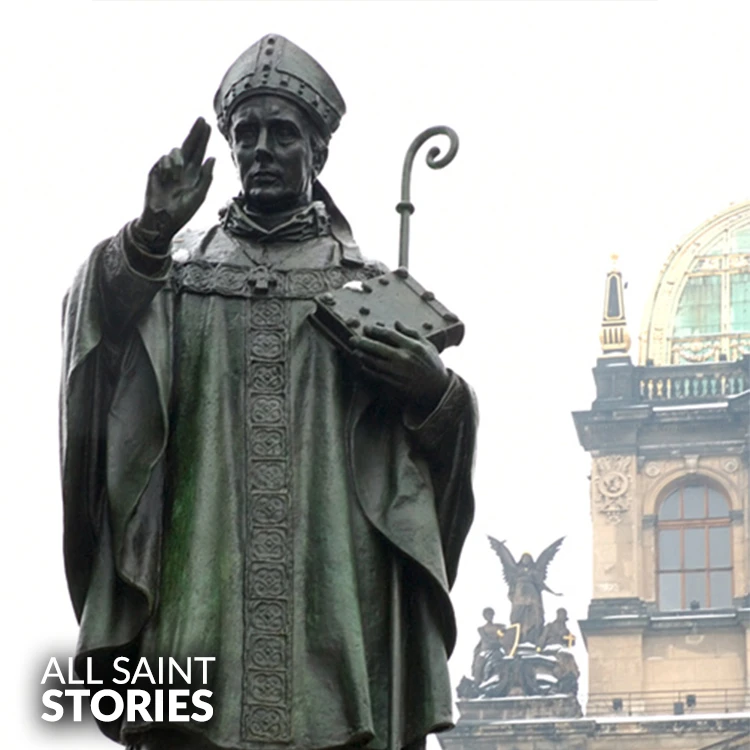Prayer Information Not Available
ST. ADALBERT OF PRAGUE
ST. ADALBERT OF PRAGUE

Saint Adalbert of Prague, born Vojtěch in 956 AD, was a Bohemian bishop and missionary dedicated to spreading Christianity in Central and Eastern Europe. Educated in Magdeburg, he became the Bishop of Prague but faced opposition due to his reforms against polygamy and the slave trade. Exiled multiple times, he traveled to Hungary and Poland before attempting to convert the Baltic Prussians. On April 23, 997 AD, he was martyred by the Prussians. His relics were bought by King Bolesław I of Poland and enshrined in Gniezno. Canonized in 999 AD, Adalbert is venerated in Bohemia, Poland, Hungary, and Germany, with his feast celebrated on April 23.
Saint Adalbert of Prague, originally named Vojtěch, was born around 956 AD in Libice nad Cidlinou, Bohemia, into the powerful Slavník family. His father, Duke Slavník, ruled over a significant territory, while his mother, Střezislava, was believed to be from the rival Přemyslid dynasty. As a child, Adalbert suffered from a severe illness, and after surviving, his parents dedicated him to the service of God.
He received an education in Magdeburg under Archbishop Adalbert of Magdeburg, from whom he adopted his Christian name. In 981, after his mentor’s death, he returned to Bohemia and was later ordained as a priest by Bishop Dietmar of Prague. Upon Dietmar’s death in 982, the young Adalbert was chosen as his successor, despite being under the canonical age. However, his attempts to reform the Church and eliminate practices such as polygamy, idolatry, and the slave trade were met with strong opposition.
By 988, facing hostility from both the nobility and clergy, Adalbert left Prague and sought refuge in Rome, where he lived as a monk at the Benedictine monastery of Saint Alexis. Five years later, under pressure from Duke Boleslaus II of Bohemia, Pope John XV instructed Adalbert to return to Prague. In 993, he founded the Břevnov Monastery, the first Benedictine monastery in Bohemia.
Despite these achievements, conflicts between the Slavník and Přemyslid families escalated. In 995, Boleslaus II, allied with the Vršovci clan, attacked the Slavník stronghold of Libice, killing Adalbert’s family members. With his position in Bohemia untenable, he left Prague once again. He traveled to Hungary, where he reportedly baptized Géza, the Grand Prince of Hungary, and his son, the future King Saint Stephen I.
Adalbert then moved to Poland, where he was welcomed by Duke Bolesław I the Brave. Wishing to continue his missionary work, he set out to evangelize the Baltic Prussians. However, his methods—using books rather than direct speech—were not well received. He was expelled from several settlements before reaching Truso (near modern Elbląg, Poland). On April 23, 997 AD, while resting after a Mass, he was ambushed by a group of Prussians led by a man named Sicco. He was struck with a spear and beheaded. His head was displayed on a pole as a warning to others.
King Bolesław I of Poland later ransomed Adalbert’s body from the Prussians for its weight in gold and enshrined it in Gniezno. His relics became a source of political and religious prestige, helping Poland assert its independence within Christendom. He was canonized in 999 AD by Pope Sylvester II.
Saint Adalbert’s relics have been the subject of historical disputes. In 1039, Duke Bretislav I of Bohemia looted Gniezno and took what he believed were Adalbert’s remains to Prague. Polish sources claim that he mistakenly took the relics of Gaudentius, Adalbert’s half-brother. Today, both Gniezno and Prague claim to house his remains.
Saint Adalbert is one of the patron saints of Bohemia, Poland, Hungary, and Prussia. His feast day is celebrated on April 23. His legacy is preserved in the bronze Gniezno Doors, which depict scenes from his life, and in the major shrines dedicated to him in Gniezno and Prague.
Video Not Found
The information on this website is compiled from various trusted sources. While we aim for accuracy, some details may be incomplete or contain discrepancies.
If you notice any errors or have additional information about this saint, please use the form on the left to share your suggestions. Your input helps us improve and maintain reliable content for everyone.
All submissions are reviewed carefully, and your personal details will remain confidential. Thank you for contributing to the accuracy and value of this resource.
Credits & Acknowledgments
- Anudina Visudhar (Malayalam) – Life of Saints for Everyday
by Msgr. Thomas Moothedan, M.A., D.D. - Saint Companions for Each Day
by A. J. M. Mausolfe & J. K. Mausolfe - US Catholic (Faith in Real Life) – Informational articles
- Wikipedia – General reference content and images
- Anastpaul.com – Saint images and reflections
- Pravachaka Sabdam (Malayalam) – Saint-related content and insights
We sincerely thank these authors and platforms for their valuable contributions. If we have unintentionally missed any attribution, please notify us, and we will make the correction promptly.
If you have any suggestion about ST. ADALBERT OF PRAGUE
Your suggestion will help improve the information about this saint. Your details will not be disclosed anywhere.
© 2025 Copyright @ www.allsaintstories.com





 English
English
 Italian
Italian
 French
French
 Spanish
Spanish
 Malayalam
Malayalam
 Russian
Russian
 Korean
Korean
 Sinhala
Sinhala
 Japanese
Japanese
 Arabic
Arabic
 Portuguese
Portuguese
 Bantu
Bantu
 Greek
Greek
 German
German
 Dutch
Dutch
 Filipino
Filipino